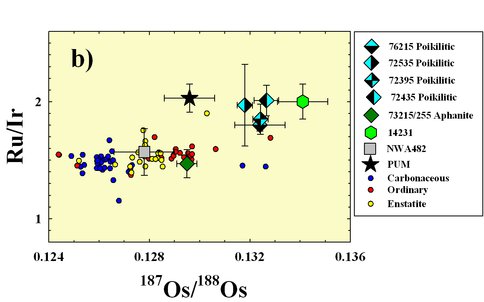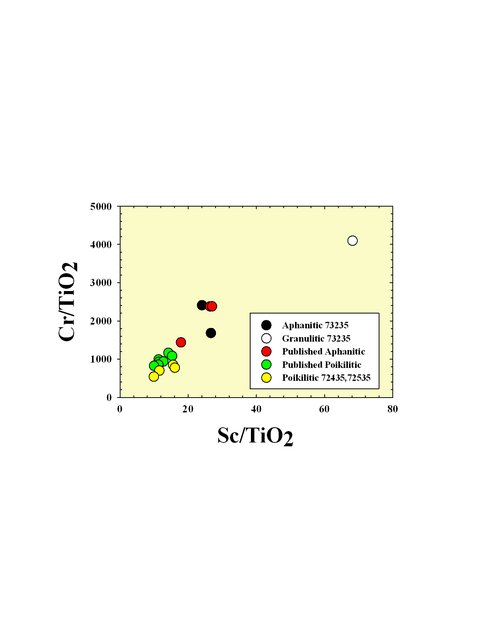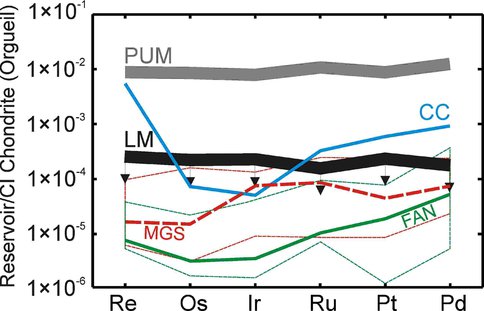2010 Annual Science Report
 NASA Goddard Space Flight Center
Reporting | SEP 2009 – AUG 2010
NASA Goddard Space Flight Center
Reporting | SEP 2009 – AUG 2010
Fingerprinting Late Additions to the Earth and Moon via the Study of Highly Siderophile Elements in Lunar Impact Melt Rocks
Project Summary
Two new lunar Apollo 17 poikilitic breccias have been examined for highly siderophile element (HSE) abundances and Os isotopic compositions. Both samples overlap chemically and isotopically with prior analyses of poikilitic breccias, indicating a consistent “fingerprint” for this Serenitatis lithology. New techniques have been developed to provide in situ analysis of breccia sub samples prior to HSE analysis. Pure lunar crust has very low concentrations of all HSE measured, including for the first time, Pd and Pt.
Project Progress
In the past year, GCA Co-Investigator Walker and colleagues at the University of Maryland (Dept. of Geology) completed the measurement of Os isotopic compositions and some highly siderophile element (HSE: Re, Os, Ir, Ru, Pt, and Pd) abundances in two Apollo 17 “poikilitic” melt breccias 72435 and 72535. The term poikilitic is a textural term, but also refers to a compositional type for melt rocks at the Apollo 17 landing site. The overarching purpose of this work is to fingerprint the HSE characteristics of late heavy bombardment (~4.0 to 3.8 Ga) additions to the Moon (and presumably the Earth) using the relative abundances of highly-siderophile elements (HSE) that occur in generally high abundance in likely lunar impactors, but in extremely low abundance in the indigenous lunar crust. Prior work on two other Apollo 17 poikilitic breccias showed that the impactor component in these rocks had higher 187Os/188Os, Pt/Ir, and Ru/Ir, and lower Os/Ir than is currently known to exist in chondritic meteorites (Figure 1). These chemical characteristics differ from another textural/petrologic type of Apollo 17 impact melt rock known as aphanitic breccias. The aphanites are finer grained rocks with fewer clasts of other rocks, compared to the poikilitic rocks. In contrast to the poikilitic breccias, we have shown that one of these aphanitic breccias has a composition that overlaps with ordinary chondrites (Figure 1). The nature of the differences between aphanitic and poikilitic lithologies remains poorly understood. The Apollo 17 site is located at the edge of the Serenitatis basin, so if there is a dominant impactor signature for this basin, it is important to assess whether that impactor component is reflected in the compositions of any or all of the melt rocks collected from the site. Differences in HSE concentrations among site melt rocks could result from heterogeneities in the impactor (unlikely for the sampling scale of the Apollo 17 site) or volatile losses of some HSE relative to others. It is more likely that the aphanitic rocks may sample an impact lithology that pre-dates the Serenitatis impact. Future work will focus on this possibility.
Figure 1A. New data for Apollo 17 poikilitic breccias 72435 and 72535 are compared with data for other lunar breccias (data from Puchtel et al., 2008), as well as with data for bulk chondrites (data from Walker et al., 2002; Horan et al., 2003; Fischer-Gödde et al., 2010). Like prior poikilitic rocks examined, both 72435 and 72535 are characterized by suprachondritic 187Os/188Os (reflecting long-term suprachondritic Re/Os), as well as suprachondritic Ru/Ir and Pd/Ir (for 72535). This implies a non-chondritic origin of impacting material.
Figure 1B. New data for Apollo 17 poikilitic breccias 72435 and 72535 are compared with data for other lunar breccias (data from Puchtel et al., 2008), as well as with data for bulk chondrites (data from Walker et al., 2002; Horan et al., 2003; Fischer-Gödde et al., 2010). Like prior poikilitic rocks examined, both 72435 and 72535 are characterized by suprachondritic 187Os/188Os (reflecting long-term suprachondritic Re/Os), as well as suprachondritic Ru/Ir and Pd/Ir (for 72535). This implies a non-chondritic origin of impacting material.
Our specific goal in the study of 72435 and 72535 was to assess the level of chemical heterogeneity for a specific petrologic type of melt rock at an Apollo landing site (Apollo 17 in this case). If additional poikilitic samples broadened the range of HSE compositions (or blurred the fingerprint), it might be impossible to interpret any of the data as a signature of the large Serenitatis impactor. On the other hand, compositional overlap with the prior poikilitic sample data would be consistent with a larger scale signature, especially since some of the poikilitic samples were collected km apart.
Poikilitic breccia 72435 was examined by Miriam Galenas, a first year Ph.D. student at UMd. During this, her first year, she was trained to conduct the rigorous analytical work required to make the state-of-the-art measurements. She was also trained to optically identify characteristics of the breccias, such as surface alteration and incorporation of older lithologies (e.g., granulitic breccias), in the pieces of breccias analyzed, that may complicate interpretations. Poikilitic breccia 72535 was examined by Iva Gerasimenko, a summer 2010 GCA intern. She did this work under the tutelage of Igor Puchtel. Results for both rocks were quite similar to the prior poikilitic rocks examined. Both 72435 and 72535 were “well behaved” from the standpoint of good linear trends on plots of Ir versus other HSE. In comparison, some prior work, especially of poikilitic breccia 76055 (data were generated by 2007-2008 GCA summer intern Lorne Loudin), showed poorly defined trends.
We typically analyze 10-20 sub samples of breccias, many of which include clasts of minerals and rocks. As a means of obtaining additional information from these complex breccia lithologies, Miriam Galenas developed an in situ measurement technique, using laser ablation inductively-coupled plasma mass spectrometry, to interrogate the rocks prior to their destructive analysis for HSE abundances. As a means of understanding better what components are present in each sub sample, 5-10 “spots” are analyzed per sub sample using a broadly focused laser beam. This allows us to characterize major, minor and some trace element abundances of diverse materials in each piece. To do this required development of a dry sawing technique allowing the generation of relatively flat surfaces for analysis (yet without contamination). The initial results for Apollo 17 samples are very encouraging (Figure 2). We are particularly interesting in identifying, characterizing, and possibly even physically separating (for HSE analysis) small pieces of granulitic breccias that may predate (perhaps by 100s of Ma) the dominant breccias.
Figure 2. Analysis of first row transition metals was done using the UMd Element 2 ICP-MS coupled with a UP213 laser ablation system. The samples were raw chips manipulated into relatively flat orientations with ceramic tweezers and aluminum foil. One sample was sawn using a dry-cut saw blade to provide a flat surface. Our initial results for fine-grained materials were similar to published values previously obtained by neutron activation analysis; in the case of the sawn surface sample the laser ablation data some elements (Sc, TiO2, V, Cr, MnO, FeO, and Cu) were within 10% of published values. On this plot the breccias also plotted within their distinct, respective fields. A granulitic breccia clast was optically identified within an aphanitic breccia host. The analysis corroborates this classification, as the granulitic clast is far from the aphanitic field.
A second project completed during this funding cycle was our study of so called “pristine” lunar crustal rocks. This work was done by assistant research scientist James Day (in collaboration with Odette James, U.S.G.S. ret.), and published as Day et al. (2010). The objective of this project was to make a preliminary assessment of HSE abundances in lunar crustal rocks that were believed to be relatively free of contaminant from impactors. Our work was centered on rocks that had previously been categorized as pristine based largely on low Ir concentrations. The study was designed to test the hypothesis that pure lunar crust has very low HSE abundances, the basis of the fingerprinting work reviewed above. This study demonstrated that some rocks previously categorized as pristine, had been contaminated by impactor materials. The overall conclusion of the study, however, was that HSE abundances in the lunar crust (at least for Mg-suite rocks and ferroan anorthosites) are quite low and that the assumption of very low Ir in the fingerprinting calculations is valid (Figure 3).
Figure 3. Estimated HSE abundances and patterns of the lunar and terrestrial mantles and crusts. Both the estimated lunar (LM) and terrestrial (PUM = primitive upper mantle) mantles have chondritic relative abundances of the HSE, but the Moon’s mantle likely has abundances >20 times lower than the Earth’s mantle. Earth’s upper continental crust (CC) has a strongly fractionated HSE pattern, with high Re, high PPGE/IPGE, and low (~40 pg g-1) abundances of Ir and Os as well as elevated 187Os/188Os (>1). Ferroan anorthosites (FAN) have consistently lower HSE abundances than the CC (>5 to 400 times lower) and shows only moderate HSE fractionation with near-chondritic 187Os/188Os. Magnesium suite rocks (MGS) have HSE abundances that are higher than in FAN, but mostly lower than in CC. HSE are greatly depleted in FAN relative to CI chondrites (1×10-4 to 8×10-6).
Finally, as a follow up to a Chemie der Erde review paper (Walker 2009) relating aspects of our understanding of HSE in terrestrial, lunar, martian and asteroidal samples to planetary accretionary (late and early) processes, we began a collaborative dynamical modeling project with Bill Bottke (Southwest Research Institute) to consider ways in which the very disparate apparent mass contributions of late accretion to Earth, Mars and the Moon could be accounted for. This work is also supported by a NASA NLSI grant to the Lunar and Planetary Institute. We have concluded that the Earth/Moon and Earth/Mars mass accretionary ratios of ~1200 and ~8, respectively, as recorded by HSE in the mantle of these planetary bodies, can only be explained by a process we term “stochastic late accretion”. Stochastic late accretion is envisioned as a process whereby a very limited number of large impactors (2000-3000 km diameter) may provide matter to the Earth and Mars. Smaller, yet still large bodies may have also provided mass to the Moon prior to formation of its crust. This work has recently been submitted to Science (Bottke et al., submitted).
Publications (wholly or partially supported by this grant)
Walker R.J. (2009) Highly siderophile elements in the Earth, Moon and Mars: Update and implications for planetary accretion and differentiation. Chemie der Erde 69, 101-125.
Day J.M.D., Walker R.J., James O.B. and Puchtel I.S. (2010) Osmium isotope and highly siderophile element systematics of the lunar crust. Earth Planet Science Lett. 289, 595-605.
Bottke W.F., Walker R.J., Day J.M.D., Nesvorny D. and Elkins-Tanton L. Stochastic late accretion to the Earth, Moon and Mars. Science, submitted August 25, 2010.
Publications
-
Day, J. M. D., Walker, R. J., James, O. B., & Puchtel, I. S. (2010). Osmium isotope and highly siderophile element systematics of the lunar crust. Earth and Planetary Science Letters, 289(3-4), 595–605. doi:10.1016/j.epsl.2009.12.001
-
Walker, R. J. (2009). Highly siderophile elements in the Earth, Moon and Mars: Update and implications for planetary accretion and differentiation. Chemie der Erde – Geochemistry, 69(2), 101–125. doi:10.1016/j.chemer.2008.10.001
-
PROJECT INVESTIGATORS:
-
PROJECT MEMBERS:
James Day
Co-Investigator
Igor Puchtel
Co-Investigator
Miriam Galenas
Graduate Student
-
RELATED OBJECTIVES:
Objective 1.1
Formation and evolution of habitable planets.




